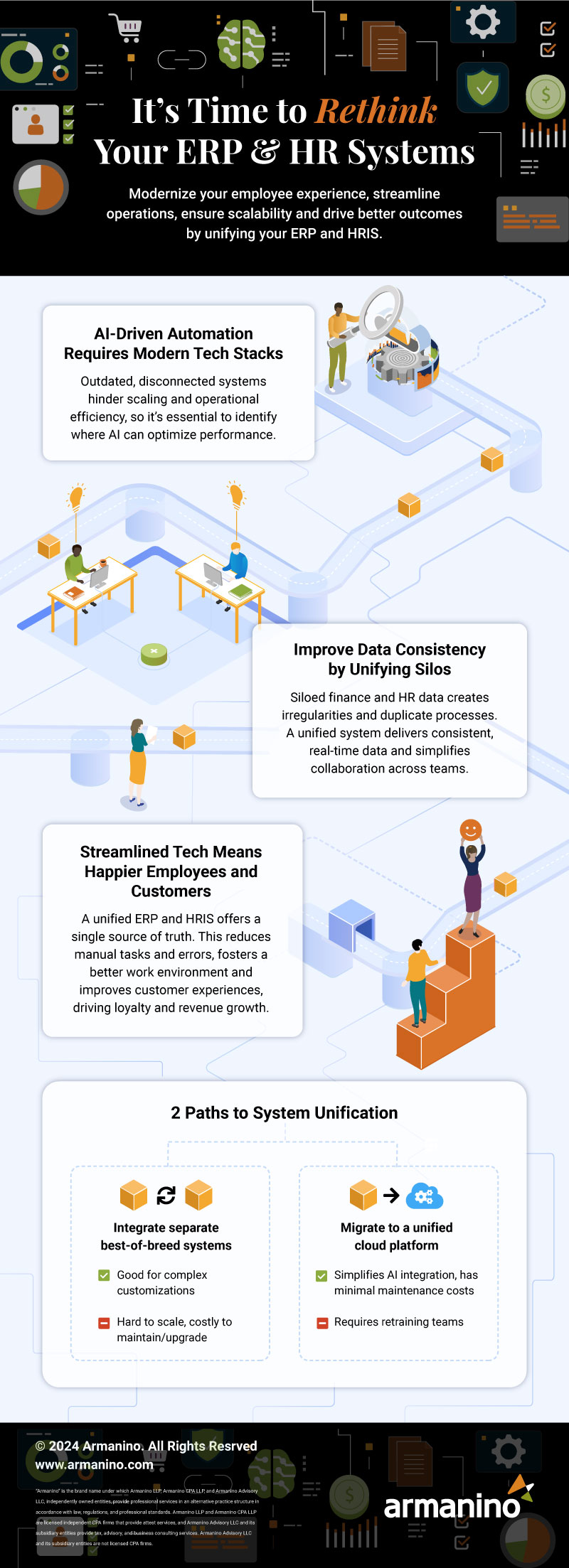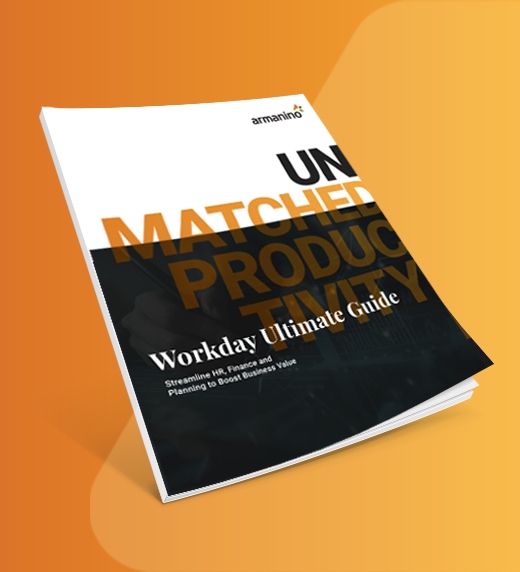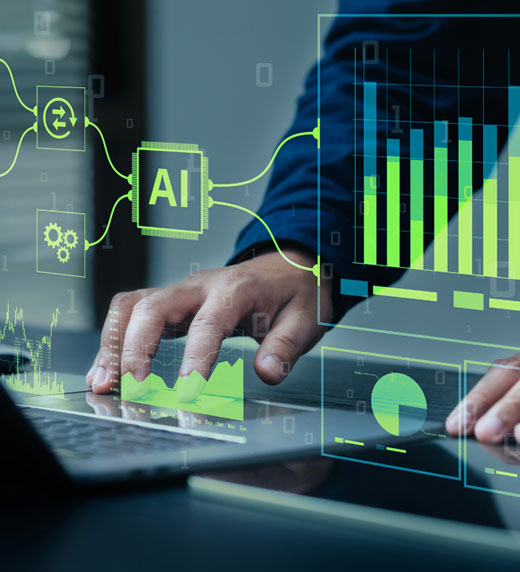
Artificial intelligence (AI) is driving automation faster than we’ve ever experienced it. This is delivering unprecedented productivity in organizations that strategically adopt AI tools. At the same time, many businesses are outgrowing their outdated enterprise resource planning (ERP) and human resource information system (HRIS) software and grappling with difficulty scaling, manual processes and underutilized software investments.
AI advancement demands that C-suite leaders rethink their current tech stacks to identify where AI can optimize performance. AI is also driving organizations to look at how they can streamline and unify operations to improve life for their employees and customers — which ultimately impacts revenue.
Streamlining operations with shared data and systems promotes better experiences and creates business alignment, leading to better outcomes. The question is: do you stay with best-of-breed (the best technology for the specific business function) ERP and HR solutions? Or do you move to an all-in-one unified platform, such as Workday, that can scale with you and simplify AI adoption?
Your HRIS and ERP hold data for your two most important assets: your people and your revenue. Traditionally, these systems are siloed. Siloed data reflects siloed functions, which means that human resources and finance teams often do not work from a single source of truth. This leads to:
In the big picture, the lack of a single source of truth makes strategic alignment between HR and finance very difficult to execute. And it costs more.
Multiple systems require time and effort to synchronize, and you need to independently update each. For example, a new cost center would need to be built, mapped and tested separately. If the systems are not synchronized, the integrity of the data is impacted. If you have it all in one system, you're only doing it once.
Having multiple systems also slows your business down — something you can’t afford in today’s hypercompetitive environment. Unifying your core finance and HR systems offers multiple business benefits.
Taking a unified approach to your core systems is not just about optimizing system outcomes. It’s about optimizing your business as a whole – streamlining how work gets done, shared, made visible and analyzed. All of which fuels a more efficient workflow and sets the stage for faster innovation. The faster you can move, with greater accuracy, the more competitive you become.
Simplifying technology lets your team focus on their core functions and get more satisfaction from their work. This improves their experience and can help you stand out as an employer of choice. The less your people must focus on the technology itself, the more they can focus on outcomes. This drives performance and productivity improvements and helps you keep and attract talent.
Here’s how a unified ERP and HRIS system can make your employees’ lives easier:
When you unify systems and improve the employee experience, you’ll set the stage for optimizing the business overall. This results in better customer experiences, particularly when customers see more streamlined, efficient services, processes and engagements with you. Better customer experiences generate customer loyalty and retention, which helps drive revenue.
Here are some of the ways a unified system can impact your business:
Of course, to realize these benefits, you need to get your stakeholders on board.
In our consulting work , we often run into finance stakeholders, particularly controllers and payroll administrators, who are deeply hesitant to change technology. When teams are familiar with systems that have worked for the last decade or more, moving to an unfamiliar one can feel risky and daunting.
We’ve seen the C-suite successfully overcome these objections by supporting seamless implementations that do not disrupt operations. For example, bringing on outsourced accounting staff to handle daily tasks can free up the finance team to learn the new system. Once teams experience how much time a unified system saves them and understand the advantages in their daily work, we typically see very positive adoption rates and employee sentiment.
There are two routes to achieving a unified system . The first option is to have an internal or third-party integration team perform manual integrations between the individual best-of-breed systems. The second option is to migrate to a unified cloud enterprise platform such as Workday. Let’s explore each.
When an integration team connects different ERP and HRIS tools, the integrations allow finance and HR data and some functionality to be shared. The downside of this approach is that it requires a significant amount of time, resources and ongoing maintenance. It also comes with the risk that when one software provider automatically upgrades, the integration will break.
Another issue when you create the platform on your own: no singular software provider holds responsibility for your integrations and upgrades. Integrating AI across the platform may be very difficult, as each system will have its own AI made by its manufacturer.
This option typically works best for companies that have complex, customized systems. But, you can run into scalability issues once your sales volumes grow. These systems are also very difficult to modernize. Some best-in-breed solutions require you to reimplement your system when an upgrade is needed, which can be expensive and time-consuming. Cost containment for build-your-own-platform models is nearly impossible.
A single platform that has ERP and HRIS functionality will have AI built into and across the entire platform. You will need to sunset your existing systems and train HR and finance on the new solution. However, these solutions are typically very intuitive to learn. In addition, the solution provider is responsible for all updates, including AI, and there is no risk of something breaking when updates are made.
Typically, when you standardize your enterprise ERP and HRIS systems on one platform, there is minimal to zero maintenance expense or IT time requirements. Overall, it’s more cost effective.
This infographic explores the signs it’s time to upgrade, describes the benefits of modern solutions and explains how rethinking your systems can drive efficiency, innovation and growth.

Want to display this infographic on your site? Copy and paste the following code. Be sure to include attribution to armanino.com with this graphic.
A unified HR and ERP solution delivers clear benefits – modernizing the business, driving better outcomes and making AI adoption much easier. Find out how our award-winning Business Application Software consultants can help you explore your options, evaluate your needs and put the power of AI to work for your organization.
Contact our experts today to assess your infrastructure and identify your critical opportunities for data insights and growth.


